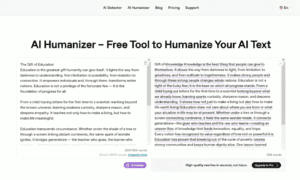For decades, nonprofits have relied on traditional grant writing methods—meticulously searching for funding opportunities, crafting compelling proposals, and navigating complex application requirements. However, the landscape is shifting. With advancements in artificial intelligence (AI), nonprofits now have powerful tools to streamline the grant writing process, maximize funding opportunities, and focus more on their mission-driven work.
The Challenges of Traditional Grant Writing
Grant writing is a time-consuming and resource-intensive process. Nonprofits must sift through thousands of potential grants, determine eligibility, and tailor their applications to each funder’s unique criteria. This often results in three key challenges:
- Limited Resources – Small nonprofits often lack dedicated grant writers and must divert time away from critical community work to complete applications.
- Complex Application Requirements – Each grant has unique requirements, making the process daunting and error-prone.
- High Competition – With more organizations competing for the same funding pools, nonprofits must ensure their applications stand out.
These obstacles create inefficiencies, leading to missed funding opportunities and burnout among nonprofit leaders. Enter AI-driven grant writing solutions.
How AI is Transforming Grant Writing
AI is revolutionizing the grant writing landscape in three key ways:
1. AI-Powered Grant Discovery
Finding the right grants is often like searching for a needle in a haystack. AI simplifies this process by analyzing vast databases of funding opportunities and matching nonprofits with the most relevant grants based on criteria such as:
- Organization type and mission
- Funding amount needed
- Geographic location
- Grant application deadlines
Platforms like Pilea leverage AI to automatically recommend highly relevant grants, reducing research time and increasing the likelihood of securing funding.
2. Automated Proposal Drafting and Editing
One of the most challenging aspects of grant writing is crafting compelling proposals that align with funder priorities. AI-driven tools assist by:
- Generating customized grant proposals based on previous successful applications.
- Suggesting improvements in clarity, persuasiveness, and structure.
- Checking for compliance with funder guidelines.
These tools don’t replace human expertise but rather enhance the efficiency of grant writers, allowing them to focus on refining content and storytelling rather than starting from scratch.
3. Predictive Analytics for Grant Success
AI can analyze historical data to predict which grants a nonprofit is most likely to win based on:
- Past funding patterns
- Funder priorities
- Application success rates
This data-driven approach helps nonprofits prioritize applications with the highest probability of success, ensuring they allocate resources wisely.
Success Story: AI in Action
Take the case of Bright Future, a small nonprofit struggling to secure funding. Using AI-powered grant discovery and proposal drafting, they identified five high-probability grants and optimized their applications based on predictive analytics. Within six months, they secured $150,000 in funding, a game-changer for their programs and operations.
Their success highlights how AI empowers nonprofits to compete for funding more effectively, even with limited resources.
The Future of AI in Grant Writing
AI is not replacing grant writers but augmenting their capabilities. As technology continues to advance, we can expect:
- More sophisticated AI grant matching with deeper funder insights.
- AI-driven collaboration tools for team-based grant writing.
- Automated compliance checks to ensure applications meet funder criteria.
AI as a Game-Changer for Nonprofits
The AI revolution in grant writing is not just about automation—it’s about empowering nonprofits to maximize their funding potential. By embracing AI-driven solutions, organizations can: Find the right grants faster; Write stronger, data-backed proposals; and Increase their chances of securing funding.
For nonprofits looking to stay competitive in the funding space, integrating AI into their grant-writing process is no longer optional—it’s a necessity.





























